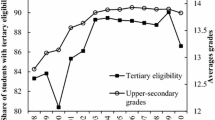Abstract
Education may play an active role in enhancing the abilities of people. It does not only help in training for the professional field but is one of the most influential ways to do the psychological, moral, and social upbringing of a person. This training makes him a better human being that leads him to be more ethical and avoid illegal activities, e.g., crime. The current study focuses on the impact of education on violent crime (Homicide) in the Asian region from 2000 to 2015. The applied techniques Mean Group, Pooled Mean Group, and Dynamic Fixed Effects proved that there exists a significant negative relationship between education and homicide, and with higher education, the tendency of violent crime declines. Moreover, higher gross domestic product per capita decreases the chances of homicide while higher population density and unemployment have significant positive effects on homicide.
Similar content being viewed by others
Notes
“Intentional homicides are estimates of unlawful homicides purposely inflicted as a result of domestic disputes, interpersonal violence, violent conflicts over land resources, integrant violence over turf or control, and predatory violence and killing by armed groups” (The World Bank 2019; p. 1). It’s important to mention that Homicide excludes self- inflicted deaths/suicides and deaths from epidemics or fatal viruses e.g. Ebola, etc.
Brunei Darussalam, Cambodia, Indonesia, and Laos People’s Democratic republic, Malaysia, Myanmar, Philippines, Singapore, Thailand, Timor-Leste, and Viet Nam.
Kazakhstan, Kyrgyzstan, Tajikistan, Turkmenistan, and Uzbekistan.
Afghanistan, Bangladesh, Bhutan, India, Iran, Maldives, Nepal, Pakistan, and Sri Lanka.
Armenia, Azerbaijan, Bahrain, Cyprus, Georgia, Iraq, Israel, Jordan Kuwait, Lebanon, Oman, Qatar, Saudi Arabia, Palestine, Syria, Turkey, United Arab Emirates, and Yemen.
Hong Kong, Macau, Japan, North Korea, South Korea, Mongolia, People’s Republic of China.
The list of countries is given in Table 4 in the “Appendix 2” and Table 5 reports the data sources. Table 6 reports the summary stats of the dataset.
Abbreviations
- MG:
-
Mean group
- PMG:
-
Pooled mean group
- DFE:
-
Dynamic fixed effects
References
Acemoglu, D., Angrist, J.: How large are human-capital externalities? Evidence from Compulsory Schooling Laws. NBER Macroecon. Annu. 15, 9–59 (2000)
Bangake, C., Eggoh, J.: International capital mobility in African countries: a panel cointegration analysis. Res. Econ. 66(1), 7–17 (2012)
Barro, R.J., Lee, J.W.: International Data on Educational Attainment: Updates and Implications. Oxford Econ Pap 53, 541–563 (2001)
Bennett, P.: The heterogeneous effects of education on crime: evidence from danish administrative twin data. Labor Econ. 52, 160–177 (2018)
Braun, C.: Crime and the minimum wage. Rev. Econ. Dyn. 32(1), 122–152 (2019)
Buonanno, P., Leonida, L.: Non-market effects of education on crime: evidence from italian regions. Econ. Educ. Rev. 28, 11–17 (2009)
Chalfin, A., Deza, M.: The intergenerational effects of education on delinquency. J. Econ. Behav. Org. 159, 553–571 (2019)
Cole, J., Gramajo, A.: Homicide rates in a cross-section of countries: evidence and interpretations. Popul. Develop. Rev. 35, 749–776 (2009)
Dee, T.S.: Are there civic returns to education? J. Public Econ. 88, 1697–1720 (2004)
Fajnzylber, P., Lederman, D., Loayza, N.: What causes violent crime? Eur. Econ. Rev. 46, 1323–1357 (2002)
Groot, W., Brink, V.: The effects of education on crime. Appl. Econ. 42, 279–289 (2010)
Haq, H.: US crime rate is down: six key reasons. Retrieved April 2, 2015, from CS Monitor: https://www.csmonitor.com/USA/2010/0524/US-crime-rate-is-down-six-key-reasons (2010)
Jacob, B., Lefgren, L.: Are idle hands devil's workshop? incapacitation, concentration, and juvenile crime. Am. Econ. Rev. 93, 1560–1577 (2003)
Jalil, H., Iqbal, M.: Urbanization and crime: a case study of Pakistan. Pak. Dev. Rev. 49(4), 741–755 (2010)
Lee, G.: Long-run equilibrium relationship between inward FDI and productivity. J. Econ. Dev. 32(2), 183–193 (2007)
Lochner, L.: Education and crime. Int. Encycl. Educ. 3, 811–843 (2008)
Lochner, L.: Education policy and crime. In: Cook, P., Ludwig, J., McCrary, J. (eds.) Controlling Crime: Strategies and Tradeoffs. University of Chicago Press, Chicago (2011)
Lochner, L., Moretti, E.: The effect of education on crime: evidence from prison inmates, arrests, and self-reports. Am. Econ. Rev. 94(1), 155–189 (2004)
Machin, S., Marie, O., Vujic, S.: The crime reducing effect of education. Econ. J. 121, 463–484 (2011)
Mao, A.: The effects of education on youth crime participation using self-reported data from NLSY97. All Theses, Clemson University, 1–42 (2013)
Meghir, C., Palme, M., Schnabel, M.: The effect of education policy on crime: an intergenerational perspective. IZA Discussion Paper No. 6142 (2011)
Mitra, D.: Pennsylvania’s Best Investment: The Social and Economic Benefits of Public Education. Pennsylvania State University, Department of Education (2005)
Nguyen, H.: Do more educated neighborhoods experience less property crime? Evidence from Indonesia. Int. J. Educ. Dev. 64, 27–37 (2019)
Orsal, D.D.K.: Comparison of panel cointegration tests. SFB 649 discussion paper No. 2007,029, Humboldt University Berlin, Collaborative Research Center 649, Economic Risk, Berlin (2007)
Pedroni, P.: Critical values for cointegration tests in heterogeneous panels with multiple regressors. Oxf. Bull. Econ. Stat. 61, 653–670 (1999)
Pesaran, M., Shin, Y., Smith, R.P.: Pooled mean group estimation of dynamic heterogeneous panels. J. Am. Stat. Assoc. 94, 621–634 (1999)
Sabates, R., Feinstein, L., Shingal, A.: Educational Inequality and Juvenile Crime: An Area Based Analysis. Department for Children, Schools, and Families. Centre for Research on the Wider Benefits of Learning Institute of Education, London (2008)
Samargandi, N., Fidrmuc, J., Ghosh, S.: Is the relationship between financial development and economic growth monotonic? Evidence from a sample of middle-income countries. World Dev. 68, 68–81 (2015)
Small Arms Survey: Firearms and violent deaths. Retrieved from Small Arms Survey Website: https://www.smallarmssurvey.org/fileadmin/docs/H-Research_Notes/SAS-Research-Note-60.pdf (2019)
Tekeli, S., Gunsoy, G.: The relation between education and economic crime: an assessment for Turkey. Proc. Soc. Behav. Sci. 106(1), 3012–3025 (2013)
The World Bank: Intentional homicides (per 100,000 people). Retrieved from The World Bank Website: https://datacatalog.worldbank.org/intentional-homicides-100000-people (2019)
United Nations Office on Drugs and Crime: Global Study on Homicide: Trends, Contexts, Data. United Nations Office on Drugs and Crime, Vienna (2013)
Funding
No funding was acquired for this study.
Author information
Authors and Affiliations
Corresponding author
Additional information
Publisher's Note
Springer Nature remains neutral with regard to jurisdictional claims in published maps and institutional affiliations.






